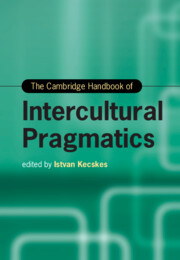Book contents
- The Cambridge Handbook of Intercultural Pragmatics
- Cambridge Handbooks in Language and Linguistics
- The Cambridge Handbook of Intercultural Pragmatics
- Copyright page
- Contents
- Figures
- Tables
- Acknowledgment
- Contributors
- Introduction The Rise of Intercultural Pragmatics
- Part I Theoretical Foundation
- Part II Key Issues in Intercultural Pragmatics Research
- 5 The Cultural, Contextual, and Computational Dimensions of Common Ground
- 6 Role of Context
- 7 (Mis/Non)Understanding in Intercultural Interactions
- 8 Creativity and Idiomaticity in Intercultural Interactions
- 9 Metaphors in Intercultural Communication
- 10 Common Ground in Linguistic Theory and Internet Pragmatics: Forms of Dynamic Multicultural Interaction
- 11 Vague Language from a Pragmatic Perspective
- 12 Humor in Intercultural Interactions
- 13 Emotion in Intercultural Interactions
- 14 Research Methods in Intercultural Pragmatics
- Part III Interface of Intercultural Pragmatics and Related Disciplines
- Part IV Intercultural Pragmatics in Different Types of Communication
- Part V Language Learning
- Index
- References
13 - Emotion in Intercultural Interactions
from Part II - Key Issues in Intercultural Pragmatics Research
Published online by Cambridge University Press: 29 September 2022
- The Cambridge Handbook of Intercultural Pragmatics
- Cambridge Handbooks in Language and Linguistics
- The Cambridge Handbook of Intercultural Pragmatics
- Copyright page
- Contents
- Figures
- Tables
- Acknowledgment
- Contributors
- Introduction The Rise of Intercultural Pragmatics
- Part I Theoretical Foundation
- Part II Key Issues in Intercultural Pragmatics Research
- 5 The Cultural, Contextual, and Computational Dimensions of Common Ground
- 6 Role of Context
- 7 (Mis/Non)Understanding in Intercultural Interactions
- 8 Creativity and Idiomaticity in Intercultural Interactions
- 9 Metaphors in Intercultural Communication
- 10 Common Ground in Linguistic Theory and Internet Pragmatics: Forms of Dynamic Multicultural Interaction
- 11 Vague Language from a Pragmatic Perspective
- 12 Humor in Intercultural Interactions
- 13 Emotion in Intercultural Interactions
- 14 Research Methods in Intercultural Pragmatics
- Part III Interface of Intercultural Pragmatics and Related Disciplines
- Part IV Intercultural Pragmatics in Different Types of Communication
- Part V Language Learning
- Index
- References
Summary
The expression of emotion in discourse (as defined in Alba-Juez and Mackenzie 2019) is treated from the perspective of intercultural pragmatics (as in, e.g, Kecskes 2004, 2011, 2014). Emotion is viewed as a pragmatic dynamical process that shows the interaction of brain-bodies-world (e.g. Van Gelder 1998, Gibbs 2010) and for that reason many aspects of its manifestation in different discourse systems/cultures are explored, taking into account not only the well-known fact that different languages and cultures may display differences in the expression of emotion at all linguistic levels (e.g. at the lexical level, a given language/culture may have a term to express an emotion that has not been conceptualized in another language (i.e. hypocognition, Levy 1973), being the cause of possible intercultural pragmalinguistic misunderstanding), but also the fact that different cultures may have different display rules (Ekman and Friesen 1975) and engage in different affective practices (Wetherell 2012), all of which may affect attempts to communicate when using a lingua franca. I argue in favor of a more comprehensive, socio-cognitive (e.g. Kecskes and Zhang 2009; Kecskes 2010) and sociopragmatic (Leech 1982, 2014) approach to the study of this kind of communication.
- Type
- Chapter
- Information
- The Cambridge Handbook of Intercultural Pragmatics , pp. 334 - 360Publisher: Cambridge University PressPrint publication year: 2022

